How do I select and install luminaires?
Luminaires, or light fixtures, fall into six categories: recessed, ceiling-mounted, suspended, architectural, wall-mounted, and plug-in.
Architectural
Architectural luminaires are integrated into the structure and are usually mounted horizontally on the wall, ceilings, or on cabinet tops. In general, they are used with linear fluorescent lamps.
- Soffits provide light downward along the walls.
- Valances direct light upward and downward along the walls. Align the valance height with the top of doors and windows, typically 6 ft, 8 in.
- Cove lighting distributes light upward, and the ceiling serves as a diffuse reflector. Cove lighting distributes light evenly throughout the room.
- Place the top of the cove or valance at least 18 in. below the ceiling to avoid hot spots or excessive brightness on the ceiling.
- As with any luminaire, it is important to avoid direct views of the lamp in an architectural luminaire. In kitchens, for example, lampholders can be mounted on top of the cabinets and concealed from direct view with a trim board.
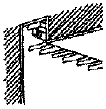 |
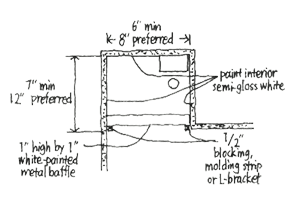 |
| Detail of soffits with baffle. Baffles are often used to hide direct view of the lamp. |
|
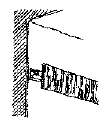 |
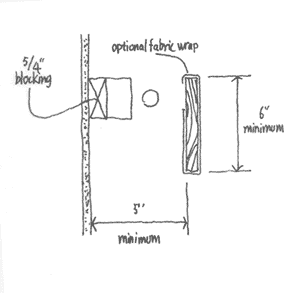 |
| Detail of fabric-covered valance luminaire |
|
 |
|
| Detail of cove luminaire | |
Ceiling-Mounted
Ceiling-mounted luminaires attach directly to the ceiling or to a ceiling track.
- Never use clear globes or thin diffusers, because they will cause glare.
- Use ceiling-mounted luminaires to provide ambient lighting, not task lighting. Supplement ambient lighting with plug-in luminaires near the task area.
- As with recessed luminaires, do not place a ceiling-mounted luminaire on a dark ceiling.
- A person's line of sight is usually straight ahead or downward. To minimize glare for these typical lines of sight, be sure a ceiling mounted luminaire is placed at least 6 ft, 8 in. above the floor.
 |
 |
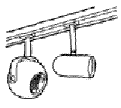 |
| Ceiling-mounted luminaires are attached directly to the ceiling or to a ceiling track. | ||
Plug-in
Plug-in luminaires are portable fixtures that plug into an electrical outlet. They include table lamps, floor lamps, torchieres, desk lamps, undercabinet lighting, and night lights. These luminaires offer flexibility to the resident because they can be moved when furniture is rearranged, and they can be positioned close to critical tasks, such as reading and sewing.
- Place adjustable desk lamps, floor lamps, or table lamps as close to the work area as possible to get the highest illuminance on the visual task. For seeing very fine details, use adjustable task lights with an integrated magnifying glass.
- Place the task light on the left side and slightly to the front if the person is right-handed. Place it to the right and slightly forward if the person is left-handed. This will reduce shadows cast by hands on papers, cutting boards, or other task surfaces.
- Place the task light beside the task, not in front of it, to avoid reflected glare from shiny surfaces like polished wood or glossy magazines.
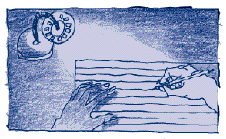 |
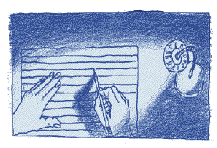 |
| A. | B. |
Place your task light slightly to the front and on the opposite side of the writing hand one writes with (a) to avoid shadows (b).
|
|
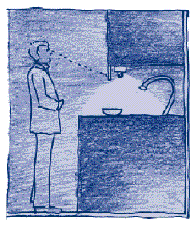 |
|
| Block direct view of lamps with a shielding board. |
|
For reading in bed, mount swing arm lamps above the head of the bed or to the side, below eye level.
|
|
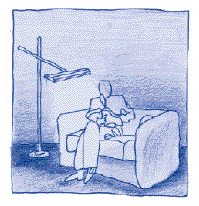 |
|
| Place a task light over the reader's shoulder, close to where he/she reads. | |
Recessed luminaires
Recessed luminaires direct light downward or toward a wall. The light distribution pattern can be narrow or broad, intense or diffuse, and provide ambient light, wall washing, or accent lighting.
- Select a deeply-recessed downlight (cutoff angle between 40° and 50° from horizontal) so the light source cannot be seen from normal lines of sight.
- Select downlights with halogen PAR incandescent lamps when accent or task lighting is desired (e.g., light above the kitchen sink). They are available in a variety of beam angles. Aim them properly to minimize direct glare. See some tips for choosing a light source.
- Use optical media, such as baffles, louvers, prismatic lenses, or diffusers to shield direct view of the lamp.
- If possible, use a matte finish inside the luminaire to eliminate seeing mirror images of the lamp.
- Do not place recessed luminaires on dark ceilings, because it will make the luminaire appear brighter and cause more glare.
- Place recessed downlight luminaries to the side and slightly in front of the position where a person stands to see the task.
- Install adjustable recessed downlight luminaires 2 ft from the wall to avoid harsh scallops on the wall.
 |
| Use slightly recessed lens, diffusers, or baffles to shield direct view of the lamp. |
Suspended luminaires
Suspended luminaires hang from the ceiling by a rod, cord, or chain and include suspended downlights, uplights, uplights/downlights, ceiling fans, and chandeliers. Suspended luminaires are used for task lights, ambient lighting, or decoration.
- The lamps in suspended luminaires used for task or ambient lighting should be shielded from direct view to reduce glare. Select a diffuser/reflector that is opaque or only slightly translucent.
- A decorative chandelier mounted above a table should be 12 in. smaller in diameter than the smallest table dimension and located 2 ft, 6 in. above the table.
- A task light mounted above a table should be located approximately 24 in. above the table. For visually demanding tasks, either use a light source that produces more light, or mount the luminaire closer to (approximately 15 in. above) the surface. To avoid a bright spot on the ceiling from a suspended luminaire that provides some "up-lighting," the luminaire should be mounted about 18 in. below the ceiling.
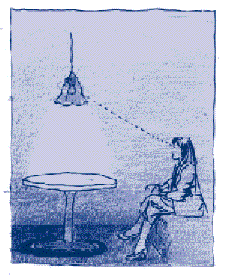 |
| Block direct view of the lamp with opaque or slightly translucent shades. |
Wall-Mounted
Wall-mounted luminaires are mounted directly to a wall surface and are appropriate for rooms with low ceilings. They can provide direct, indirect, or diffuse lighting.
- Wall-mounted luminaires can be used to provide diffuse light in hallways, dining rooms, living rooms, and bedrooms.
- Conceal the lamp with opaque or semi-translucent materials. Do not install bright wall-mounted luminaires against a dark color wall.
- Mount wall-mounted luminaires so the lamp cannot be seen from above or below. Install the outlet box for the luminaire approximately 5 ft, 6 in. above the floor.
- Choose wall-mounted luminaires that comply with the Americans with Disabilities Act (ADA). In public spaces, such as corridors, the ADA limits the outward extension of a wall-mounted luminaire to 4 in. if it is mounted lower than 6 ft, 8 in. above the floor.
 |
 |
| Some tips for choosing luminaires | |
- Avoid clear-glass luminaires.
- For luminaires that have a visible reflector, select a semi-specular or matte finish. Luminaires with specular reflectors can reflect the image of the light source and produce glare.
- Paint inside of architectural luminaires (soffits, coves, and valances) a matte white color to provide more diffuse light in the room.
- Look for the Energy Star label on the luminaire.


